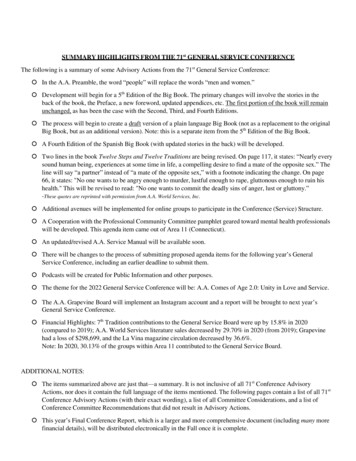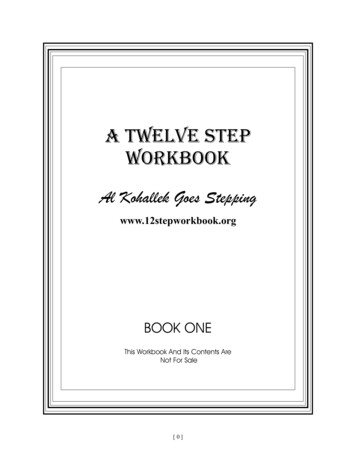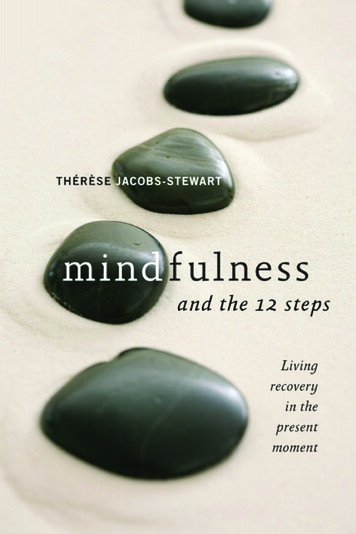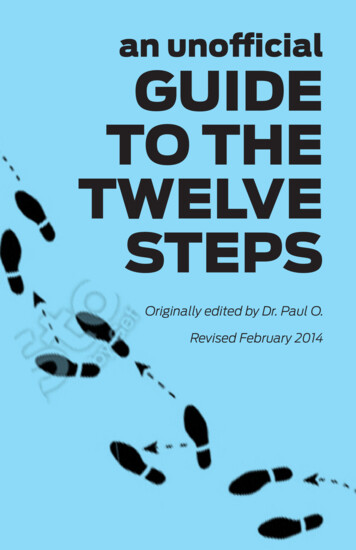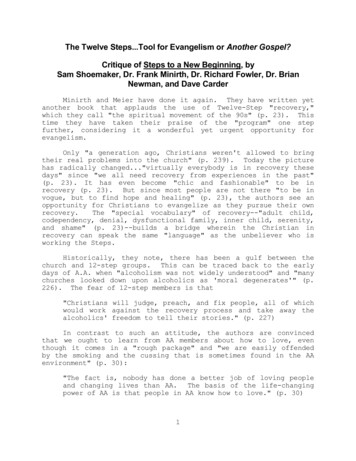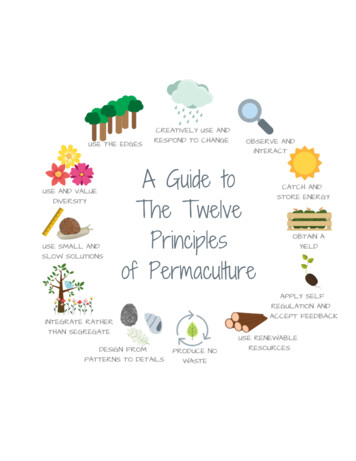
Transcription
A Guide toThe TwelvePrinciplesof Permaculture
Thank you for purchasing our Guide to Permaculture Principles. Pleaseunderstand this copy is for your personal use. You may print as manycopies as you like for your own family. You do not have permission todistribute or sell this curriculum. To purchase more copies pleasecome to HappyHolisticHomestead.com.Copyright 2020 by Roxanne Ahern, Happy Holistic Homestead.Fayetteville, ArkansasAll Rights ReservedCreated by Roxanne AhernPlease contact admin@happyholistichomestead.com to report errorsor to purchase additional copies.
How to use thiscurriculumWelcome! We are so happy you are here to learnmore about the transformative philosphy ofPermaculture. Inside you will find an Introduction,an explanation of each of the 12 principles, a "digdeeper" section after each principle designed toprovoke deeper thought and conversation, and asection that walks you through the permaculturedesign process that includes an area to track theprogress on that space for an extended period oftime.This guide is flexible and can be read through all atonce, used on a daily basis for a unit study, or useda weekly basis. If timing to be complete with time toplan and create a Spring garden in the NorthernHemisphere then start in the beginning ofDecember and do one section a week. For theSouthern hemisphere begin in June. However thereis no "wrong time" to learn about these principles,so feel free to begin when it makes sense for youand your family.
What isPermaculture?Permaculture is a way of approaching designin which we seek to work in cooperation withthe given environment rather than against it.It is most commonly used to describe a formof agriculture, but the 12 principles it isbased on can really be applied to any type ofdesign. Yes, I said principles. As far as I know,permaculture is the only type of gardeningthat has a set of ethics. The term"permaculture" was created by Bill Mollisonand and David Holmgren in the 1970’s. Theword itself is a combination of the words“permanent” and “agriculture”, and with itsfocus on perennials, rather than annuals (likethe current industrial agricultural model isfocused) it would be easy to sum it up thatway. Food growing with a concentration onperennials.
Yet that description would not be doingjustice to the potentially revolutionary systemthat is permaculture, because althoughgrowing food is one benefit, there are alsomany others. The central ethics, in order, are:Design for the earth. Design for yourself(people). Create a surplus (that can beshared). This system can be applied to anyscale, and can be perfect to maximize theusefulness and productivity of very smallspaces. The principles of permaculture arealso helpful beyond the garden or farm andcan be used to troubleshoot and problemsolve in many different areas of life. Read onto learn more about each of the 12principles.Dig Deeper:Imagine a world in which the central ethics ofpermaculture were applied to everybusiness. What do you think that would look
like? What changes can you imagine that wemight see?Notes:
Principle 1:Observe and interactYes. Do that! Spend some time at the site youwill be designing. Understand the weatherpatterns, the way the water moves on thesite, the topography, and the uniquemicroclimates. Where does the sun hit theproperty? Where is there shade? Is there anoise problem? A view that should beprotected or blocked? When designing withpermaculture, there is no such thing as a onesize fits all approach. The design will be asunique as the property and the people it isbeing created for.Dig Deeper:Take a few moments to observe yourcurrent environment and share some thingsyou notice. Is it cool or warm? Bright ordark? How does it make you feel? What
is one thing you really like? One thing youwould change?Notes:
Principle 2:Catch and store energyWe know sunlight is energy. But somepeople think the only way to catch the sunand store its energy would be solar panelsattached to a battery. There are many waysto capture the sun's energy, like in grass ora vegetable garden. Grass is energy forlivestock and vegetables are energy forhumans. What about barrels of water in agreenhouse that can collect heat during theday and release it at night to keep plantswarm? What about capturing the energy ofa flowing stream with a water turbine andusing it to power a pump? The possibilitiesare limitless. There are many energysources all around us, yet when we think ofenergy a lot of people think only ofelectricity that has been generated by usingpetroleum. There are many other options!
Dig DeeperCan you think of 2 examples of caught andstored energy? What is a way human bodiescatch and store energy?Notes:
Principle 3:Obtain a yieldBeauty can be a yield. But, unless it is yourabsolute favorite plant ever, it should alsoserve another purpose. When thinking abouthow to landscape a home there is absolutelyno reason why a majority of the plantsshould not be edible ones. There are manyornamentals that are also entirely or partiallyedible, (like daylilies, roses, or violets, just toname a few). If you have a favorite type offruit or vegetable and it grows in yourclimate, figure out how to grow it. Getrewarded for all of your hard work! When Iam placing an element into a design I like tosee that it serves at least three purposes. Forexample: beautiful, edible, pollinator habitat.Or provides shade, is nitrogen fixing,provides forage for my chickens.
I do this when obtaining animals for our farmas well (Chickens: eggs, bug control, manure.Angora rabbits: fiber, companionship,manure). If something does not serve at leastthree different purposes I usually decide Icould make a better choice.Dig Deeper:Do a bit of research and discover five plantsthat grow wild in your area that are alsoedible. Research and identify three local"weeds". Are they edible? Medicinal?Notes:
Principal 4:Apply self regulation andaccept feedbackPay attention to the systems you have put inplace and make necessary adjustments andimprovements. Sometimes a need to be rightcan prevent us from seeing a situation forwhat it really is and prevent us from takingthe steps that would create true success. Itcan be difficult to admit something isn'tworking when we have invested our time,enegy, and money. Be honest about what isand is not working, and be open to feedback,from the environment, animals, and people.Also, when choosing plants and animals foran environment make sure to take intoaccount how large they will be when theyreach their full size.
Dig Deeper:Write about a time in your life when you usedself regulation and feedback to improve askillNotes:
Principle 5:Use renewable resourcesSome resources, such as oil, are finite andnot renewable. Some are, especially whenmanaged properly. Using wood for heat in anefficient wood stove with proper forestrymanagement ensures that there will be anever ending supply of wood to use as heat.Adding shade (with a tree or a grape arbor,for example) around a home and positioningit in such a way to protect it from theextreme mid day heat in Summer can reducethe need for artificial climate control andmuch reduce the amount of energy that willbe needed to keep it comfortable for theinhabitants. A pecan tree can be used forshade, for food, for wood, and eventually forheat or compost. More can be planted. Treesare an awesome example of something thatcan be a renewable resource.
Dig Deeper:Name five things you use in your daily lifethat are made with renewable resources andfive things that are made with non renewableresources. Pick one of these items and learnabout the production process. Write aboutwhat you learnNotes:
Principle 6:Produce no wasteWhat a radical idea today. No waste? Mosthouseholds in the U.S. fill up one or more ofthose giant flip top garbage cans everyweek. That doesn’t include the large itemslike furniture or appliances that get taken tothe dump. How many people take foodscraps that are completely biodegradableand put them in a non biodegradableplastic bag which will be placed in a landfilland will still be sitting there when theperson who created that garbage is nolonger on the planet? Meanwhile, thetopsoil in our country has been muchreduced in the last couple of hundred years(this is thanks to our broken wastemanagement systems, deforestation, andconventional agriculture but that is anotherissue) and the the soil that remains is oftennutrient deficient.
The food we grow can only be a nutrientdense as the soil that it is grown in. So howabout returning the nutrients to the soilthrough composting? It is not difficult. Orshould I say it is as difficult as people like it tobe. Some folks like to turn their compostoften, or have worm bins or big bins theykeep it in which can be turned with a handle.We like a put it and forget it system. We havea three bin system that we constructed outof old pallets we got for free. By the time wefill up the third bin, the compost in the firstbin is broken down and ready for use. Theleaves that get bagged up and thrown away?These make an excellent mulch to put onyour garden beds in the winter, or add themto your compost. If you have no use for yourcompost, for example if you live in anapartment and have absolutely no plants,consider reaching out to your community tosee if anyone would want your food waste sothey can compost it, a small local farm orcommunity garden might be a good option.
Dig Deeper:Do you compost or recycle? If you do notalready research your local options forrecycling and spend some time learningabout composting. There are also a numberof ways to switch to second hand or zerowaste options for everyday items. What arethree things you can do to reduce waste inyour home?Notes:
Principal 7:Design from patternsto detailsThere are many patterns that are repeated innature that you can mimic in your designs. Aspiral, the veins in a leaf, a wave, etc. Thesepatterns occur naturally again and againbecause they work, and they are functional.Observe them and notice where they wouldbe appropriate in your design. Allow natureto be your muse and also notice howsystems you already have in place maymirror those that occur naturally. Forexample, drip irrigation resembles acirculatory system. Also, patterns in naturecan help you to think of simple designsolutions. For example, a spiral could help tocreate a sense of privacy or escape in arelatively small space.
Dig Deeper:Spend some time in nature observingpatterns and shapes. Is there a particularpattern you notice repeating itself?Notes:
Principle 8:Integrate rather thansegregateIn many agricultural models today, thesystem in place is called a mono crop. Acresof corn or soy beans, a huge orchard withone kind of tree. The thought processbehind this is that if you have one kind ofplant it will all be easier to manage andmaintain with specialized machines. Theresult of these systems is soil becomesdepleted and it creates an environment inwhich a particular pest species canproliferate itself in an unchecked waybecause it has an unlimited food supply. Ifyou observe the way plants naturally occuryou will notice there is never ever acres andacres of just one plant and nothing else. Inpermaculture we plant groups of plantstogether.
These groupings are sometimes referred toas guilds. A heavy feeding fruit tree would getplanted with a nitrogen fixing plant to putnitrogen back in the soil, pollinator plants toattract bees and butterflies, pest deterringplants like nasturtium or garlic, a ring ofdaffodils to suppress grass growth and adynamic accumulator species like comfrey orconeflower that pull nutrients up from soiland can be chopped and used as mulch thatwill feed the tree. Instead of chemicalfertilizers and pesticides, we can benefit fromthe intelligence of natural systems. Plantingin guilds may take more planning and work inthe beginning phase, but they can save youtime and labor in the future. This will alsolead to increased yields.Dig Deeper:Think of three vegetables, fruits, or herbs thatyou like to eat. Strawberries? Tomatoes?
Cucumbers? Basil? Find 3 companion plantsfor each. This is as simple as doing an internetsearch using the name of the foods you chosefollowed by "beneficial companion plants".Record your findingsBuild a GuildA guild is a group of plants that support eachother. Fruit trees are often at the center ofsuch guilds, with plants chosen to supportthem. Find a fruit tree you like that alsogrows well in your area. Then research eachterm in the following list and write one or twooptions for each. Make sure the plants youchoose work well in your growing zone.Nitrogen fixer
Dynamic accumulatorInsectiary/Pollinator habitatGrass/weed suppressionPest repellentVine layerFungi LayerGroundcoverDraw and label your guild here:
Notes:
Principle 9:Use small and slow solutionsWhen people begin to grow their own foodsometimes they can be turned off by theamount of time perennial crops can take toproduce. They want food now! Or in a fewmonths at the most. And that is ok! I lovesome of the annual vegetables. But you canmake the same investment of time andmoney into a perennial crop, like anasparagus bed, a berry bush, or a fruit tree,and in a few years you have an establishedcrop that will yield year after year with verylittle input. It can be hard to wait, but worthit! And if you plant several trees that bearfruit and nuts, and many berry bushes, andcrops like artichokes and asparagus, in a fewyears the reliance on your annual crops willbe much reduced.In our society there tends to be an emphasis
on doing everything quickly. Instantly ifpossible. For example, soil amendments likeworm castings and compost will not give theinstant result of a quick release chemicalfertilizer, but the soil itself will be growinghealthier and will, in time, produce betterresults than if the chemical fertilizers hadbeen used. In the same vein, trying to findnatural solutions to pest problems, may takelonger but will produce better long termresults than pesticides. Growing our ownfood or seeking out farmers who useenvironmentally practices might seem smallin the grand scheme of things, and theymight be slower than going to thesupermarket. But many people makingpositive, small, slow changes will add up to abetter world.Dig Deeper:Think of a way you have used small and slowsolutions in your own life to
make changes. Think of something that takestime, but is worthitNotes:
Principle 10:Use and value diversityDiversity is important when growing foodbecause if you plant all one type of anythingthen your crop becomes vulnerable to attackby disease and predators. For example,instead of planting ten fruit trees that are allone or two types of apple, plant 3 apples, acouple of pears, a couple of stone fruits likepeaches or cherries, and a couple of jujubesor paw paws. Ensure you have the correctnumber and type of pollinators for yourtrees, but get as many different varieties asyou can. That way if it is a bad apple yearbecause of weather, pests, or anothervariable, hopefully a few of the other fruittrees do well. This is true in the annualgarden as well. Plant different varieties ofsquash, melons and tomatoes.
You will find that some of them do better inyour climate, are lower maintenance, andmore resistant to predators.Dig Deeper:Think about your own life and how youbenefit personally from diversity. What if youonly learned one subject in school? What if allof your family members or friends wereexactly alike? Write about your thoughtsNotes:
Principle 11:Use the edgesThe “edges” are where two spaces meet andthey can be areas with many possibilities. Thearea where your yard meets the woods, orthe grass meets the pond, for example, cancreate a microclimate that could be perfectfor cultivating a certain crop that does notexist anywhere else on the property. Also,take into account the shape of your gardenbeds, the keyhole bed is a popular shape inpermaculture because it maximizes growingspace and minimizes path space. Realizeanywhere that is a little different on your sitehas its own microclimate and possibilities.Example: A shed with a wall that gets half sunhalf shade, whose roof is angled the samedirection so the ground next to it gets runofffrom rainwater. This could be a great spot toplant something like an elderberry.
Dig Deeper:Find an "edge" in your community. The bankof a pond at a local park, or the area thatconnects a greenbelt to a neighborhood.Observe the edge and notice how different itis when compared to the land it is next to.Animals? Plants? Moisture differences?Notes:
Principle 12:Creatively use andrespond to changeUnderstand that no two years will beexactly alike. Keep a notebook and make apractice of bringing it with you when youharvest fruit and vegetables or domaintenance. Take notes and createinformed courses of action. In theperennial garden certain plants will growlarger year after year until they reach theircomplete size, which means microclimatesunder and near trees and shrubs willchange and support different types ofplants and animal life.Keep track of things like when the first andlast freeze occur, when plants go intoblossom and fruit, when harvests occur,rainfall, and pests and disease that youobserve.
DIg Deeper:Have you ever changed schools, moved, orexperienced the birth of a sibling? Think of atime in your life when you have experiencedchange. How did you respond?In what ways do you think permacultureprinciples could be used outside ofgardening and farming to solve problems?
Could permaculture be used to grow food ona large scale? Why or why not?Notes:
Create YourPermaculture GardenStep 1: Observe your space. Take notes. Payattention especially to the following things:The path of the sun across your space, theway water flows, access to irrigation, views topreserve or block, soil quality, noise. Ofcourse include any other factors you wouldlike.Notes:
Step 2: Do a soil test. This is very simple. Doan internet search for "soil test in a jar". Thiswill allow you to get an idea of your soil type.You can also reach out to your localextension office, many of them offer free indepth soil testing and analysis. This is animportant step if you plan to plant in theground, not important if you will bepurchasing soil to fill containers or raisedbeds. Just make sure the soil you purchase isof a good quality. In subsequent years, evenif planting in beds and containers, the soil willneed to be amended. This is why compostingis important. It will provide a free source offertilizer for the garden.Notes:
Step 3: Draw MapsUse the information in your notes to create avisual representation of the space. This canbe done by hand or on a digital program.Google Earth is a great way to get aerial viewmaps of the space (if it is outdoor that is,some of you may be planning to grow awindow garden or other indoor space).Google Earth maps can be copied intoprograms like Power Point or Keynote anddrawn directly on. Maps can also be donecompletely by hand. Make sure to add anorth arrow on map(s). Include importantinformation like the way the sun movesacross the property and the way the waterflows. All of this information can be includedin one map or many maps, it is a personalpreference. I personally like to put as muchvisual information on one map as possible sothat when designing I have more informationto reference in one place.
MAP 1
MAP 2
Notes:
Step 4: Figure out what you want to grow. Ifyou don't already know it, find out what yourhardiness zone is. Just type your zip code and"growing zone" into your internet searchengine. When choosing things to grow makesure they are hardy in your zone. I alsoencourage that for perennial plantings put alittle time into researching plants thatnaturally occur in your area instead ofautomatically leaning toward all the optionsat the supermarket. Remember that food ingrocery stores is there because it stores andships well and much of it probably comesfrom very far away. For example, in theSoutheast, apples and grapes are widelyavailable at the grocery store but are difficultto grow because of pests and disease. Whilepaw paws, muscadines, elderberries,passionfruit, and many others, are easy togrow with few inputs, but they would notstore or ship well. Growing your own food isfun because you can grow your favorites, but
it is also fun to grow things unavailable at thestore. As far as the environment andsustainability are concerned, it makes moresense, and will create less frustration, to growthings that thrive in our environment ratherthan forcing things to grow. Our current foodsystem is propped up by massive amounts ofchemical fertilizers, pesticides, and a cheaplabor force. We need to create systems thatfeed us while also being ethical and goodstewards of natural resources. Leaningtowards plants that naturally thrive in aparticular environment is a great way to helpmake this shift. Our food supply chainconsists of massive production operationsthat ship all over the world. Smaller, morelocalized food systems will help to increasethe resilience of communities. Buying directlyfrom small farmers whose ethics are inalignment with our own can make this foodmore affordable to buy and to produce bycutting out the middlemen.
Things I Want To Grow:
Step 5: Design your growing space.Be mindful of the way the sun travels and puttaller plants in a postion that will not shadeout smaller plants.Don't forget the possibilites of verticalgrowing, especially in small spaces. Trellises,archways, arbors, and shelves can all be waysto grow more and have the added benefit ofincreasing shade.Look in books, magazines, and online forideas of how you want your space to look.Pinterest can be a great way to save ideasonline while printing and taking copies tostore in a notebook can also be a good wayto save ideas.If designing for a large space, be realisticabout how long it will take to implement yourplans. Try designing phases and setting goalsover a period of time.Don't forget to consider budget. Do researchabout how much each element of yourdesign will cost.
Determine where to obtain inputs for yourgarden. Even if you implement a compostingsystem, you will probably not have compsotthat is ready for use by the time you installyour garden. Depending on the size of yourgrowing space you may need more inputsthan what you can produce yourself. Reachout to local farms to see if they have excessmanure, restaurants can be sought out forcompostable food waste. You can even reachout to family and friends to see if they wouldallow you to come pick up their food scraps.Wood chips can be a good material to blockweeds and retain moisture and some treeservices are willing to drop off loads for free.List of sources for additional inputs:Think about ways that you could create asurplus. What would you do with it?
My Design
Once your growing space is intstalled makesure to take regular notes about what isgoing on. What is working? What isn't? Arethere certain varieties that seem to bethriving more than others? I also recordwhen I prune, weed, add mulch, and othermaintenance chores. I like to take writtennotes and I also like to take regularphotographs to record harvests, when fruittrees start to bud, damage from pests anddisease and more. Video walkthroughs areanother good way to record alot ofinformation. At the end of your first seasonor year, whatever makes more sense forplanning purposes, go through all your notesto make a well informed plan for thefollowing growing season. Did what youcreated work well the first time around? Ordo you need to make some adjustments?Keeping good records ensures that even themistakes are not wasted because theybecome instructive. Good luck!
Notes:Month 1:Month 2:Month 3:Month 4:Month 5:Month 6:
Month 7:Month 8:Month 9:Month 10:Month 11:Month 12:
Plans For Next Season:
permaculture is the only type of gardening that has a set of ethics. The term "permaculture" was created by Bill Mollison and and David Holmgren in the 1970’s. The word itself is a combination of the words “permanent” and “agriculture”, and with its focus on perennials, rather t


